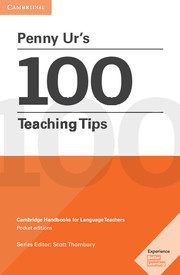Book contents
- Frontmatter
- Contents
- Why I Wrote this Book
- Beginning and Ending the Lesson
- The Coursebook
- Discipline
- Error Correction
- Games
- Grammar
- Group Work
- Heterogeneous (Mixed-Level) Classes
- Homework
- Interest
- Listening
- Pronunciation
- Reading Comprehension
- Speaking Activities
- Teacher Talk
- Testing and Assessment
- Vocabulary Teaching
- Writing
- P.S.
- Index
- Photo Acknowledgements
Teacher Talk
Published online by Cambridge University Press: 17 November 2023
- Frontmatter
- Contents
- Why I Wrote this Book
- Beginning and Ending the Lesson
- The Coursebook
- Discipline
- Error Correction
- Games
- Grammar
- Group Work
- Heterogeneous (Mixed-Level) Classes
- Homework
- Interest
- Listening
- Pronunciation
- Reading Comprehension
- Speaking Activities
- Teacher Talk
- Testing and Assessment
- Vocabulary Teaching
- Writing
- P.S.
- Index
- Photo Acknowledgements
Summary
In many situations teacher talk is the only source of spoken English the students have, so it's pretty important. But there's no point talking a lot of English if the students don't understand most of it. It becomes just a flood of incomprehensible noise, and all they learn is that English is incomprehensible! Teacher talk has to be clear and adapted to students’ level.
77 Talk a lot
78 Keep eye contact
79 Tell stories
80 Teach common classroom language
81 Use mother tongue occasionally
82 Invite short responses
77 Talk a lot
Contrary to some opinions you might have heard, lots of teacher talk in English is actually a good thing. It's an excellent source of English language comprehensible input.
The idea of the learner-centred classroom does not mean that students should be talking most of the time and the teacher keeping quiet, acting only as a facilitator. Of course, you want your students to be active language users for much of the lesson time; but you also want to give them opportunities to hear lots of comprehensible English, and learn from it. And the best such opportunities are provided by your own speech. It's likely to be better than recorded or filmed input, because it's directly addressed to your students, you can design and adapt it to suit their levels and needs, and it's ‘live’, taking place in real time.
Your spoken input is particularly important if your students hear little or no English outside your classroom – which is true for most teaching situations in the world today. In such cases, you are the only source of good spoken English your students will have. Listening to each other is not a substitute for listening to you. They need to have opportunities to listen to and understand input that is slightly more difficult and a lot more fluent than that which they can produce themselves.
Teacher talk can take the form of explicit language teaching: explanations of grammar or vocabulary, for example. Or it can be instructions on how to do an activity or what the homework is. Or feedback on student activity: corrections, comments on how something went, a summary of a discussion. Or initiatives of your own to let them hear you talk: stories (see Tip 79), or short presentations or talks (on the importance of learning English, for example!).
- Type
- Chapter
- Information
- Penny Ur's 100 Teaching TipsCambridge Handbooks for Language Teachers, pp. 91 - 97Publisher: Cambridge University PressPrint publication year: 2016

